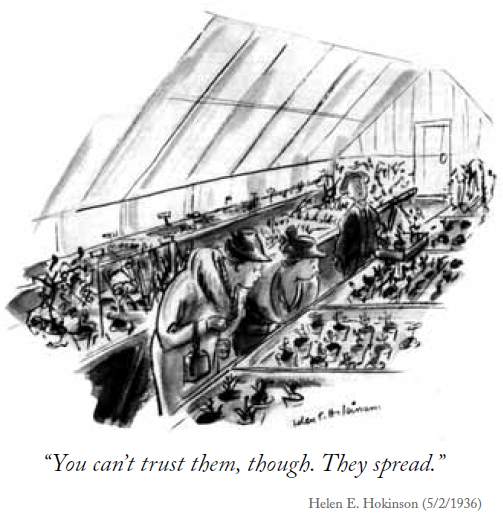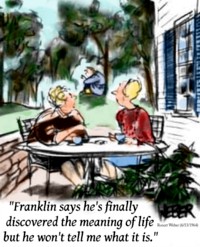Genes
They are in you and in me; they created us, body and mind; and their preservation is the ultimate rationale for our existence ... they go by the name of genes, and we are their survival machines.[20]
All species that are here with us today are the descendents of the original life forms and have been equally successful at surviving. When we consider life on the planet we see animals and plants that live for hundreds of years and others that live for a few hours; or even less in the case of some bacteria.
So survival as a species does not depend on individuals surviving for a long time but on the way the species has organised itself to survive collectively. No doubt many survival strategies have been tried at some time since life has existed but those that failed have, by definition, not survived.
As you know, genes are sequences of genetic code that provide the instructions for building cells in animals and plants and determine the relationship of each cell to the remainder. They are stored and copied on very long molecules called chromosomes.
Chromosomes are long single chemical molecules of DNA (Deoxyribonucleic acid) that are encoded with genes along their length; like the songs along a recording tape.
Thus our genes determine the development and functioning of our organism (the colony of cells that is us): that we are human, our size, shape and colour and our various other natural characterises and abilities.
Human cells each have 23 pairs of chromosomes (22 pairs of autosomes – one from each parent - and one pair of sex chromosomes), giving a total of 46 per cell. For convenience the autosomes are numbered according to molecular size (1 to 22). This number differs from creature to creature but 46 is critical to human viability. For example three copies of the small chromosome 21 causes Down Syndrome. An extra copy of a larger chromosome causes the cell, foetus or infant to be non-viable.
Sex chromosomes are described as X (female) and Y (male) because of what they look like under a microscope. Girls have two Xs and boys have XY . We all need at least one X to survive – it contains some important genes.
As with all chromosomes we get one of these from each parent. Thus mothers have two Xs from which to choose (randomly) while fathers have only one X. The Y chromosome of boys only comes from the father (mothers have none); thus the father's spermatozoa that succeeds in fertilisation determines the sex of a child. We have known this for little over half a dozen generations.
Not all of our chromosomes are equal; some carry a lot more genes than others and each has a lot of 'none-coding' DNA, the function of which is still being investigated.
Individually genes might decide what colour our eyes are. But particular collections and relationships of genes carry the design for successful organisms and through that design, their survival strategy.
We share genes with almost every living thing. Genes can be taken from plants and put into animals and vice versa. Some of these genes go back to the beginning of life on earth. In this way it is genes that survive not the plants and animals that carry them. Not of course the actual gene, but the message it carries, has been repeated over and over for billions of years. This characteristic has led biologists to see life as the 'selfish' struggle of genes to survive.
Genes like, the tunes on a recording tape, are just message (idea/design) carriers. So this struggle is a struggle of competing ideas (designs).
We all start as one cell that first divides in two then four, eight and so on. DNA tells each cell how to develop, what it will do and how it will work with other cells. These messages decide the kind of cell it will be and if a cell will grow into a tree, the dog that pees on the tree or the person that is the dog's master.
We think that complex life, like trees, dogs and people, evolved from very simple cells that began between 2 and 3 thousand million years ago and have been competing for resources (like, space food and energy) with each other ever since. There are now many kinds of cells and many are very complex; like towns. But it is not the cells that compete to survive but the building instructions; the messages carried in the DNA.
Just as a line of computer code won't work alone or without a computer, messages in genes can't work alone or without a cell that can read them. They need to be part of a successful team. This consists of a cell, to carry out their instructions, and other genes, which together make a complete instruction.
Like this sentence each word alone (although very good in its own way) is pretty useless without the others and by rearranging the number of each and their order I can get lots of different messages and meanings. As I discussed above this meaning might include the way the sentence looks or rhymes or its metaphor or simile.
Successful genes are those that are already members of a successful message in a successful cell, so this message is passed on to lots more cells. Unsuccessful genes do not result in as many cells that can compete and their message is in less and less cells until it is lost altogether.
To survive genes need to be in messages that code for cells that divide quickly, are themselves good at surviving and pass on their genes without errors. So messages that help cells have these properties have won over those that were not so good at surviving over the past 2,000,000,000 years.
One way cells/genes have found of surviving is to build clusters, with different versions of themselves changing to do different things. We call these clusters of cells an animal or a plant. The instructions for building a cell also include the instructions for organising copies of itself into a bird, a bee, a tree or you.
Now all surviving cells are very good at passing on genes and genes are very good at building animals and plants that can, in turn, compete for survival and resources. Everyone and everything alive today is designed and built by successful messages carried by genes; those that survived at the expense of others. We are in that sense the products of the most ruthless, opportunistic and lucky messages, genes, cells, animals and human ancestors.

Of course if genes were always copied (inherited) exactly, the very first successful messages would still be building the first successful cells. The planet would have only one kind of cell for each environment and there would be no need to change things until the climate or some other external factor changed to create a totally new environment.
It seems that very slow change was the case for a long time. Replicating molecules took about 1,000 million years to evolve into the first cells and these took almost as long to evolve into the first bacteria and algae. These took a further 3,000 million years to release enough oxygen into the atmosphere to support complex cells. Complex life has only been around for about 500 million years.
In more complex animals genes can change more quickly, new ones are constantly being created and are tested against the old. Genes even evolved sex to speed this process up. Rapid evolution then led to the large dinosaurs about 100 million years ago and to the first mammals about 60 million years ago. Different versions allow different animals to compete for the same resources. If a new version doesn't compete effectively it won't survive; but if the changed animal works better, the new gene will be passed on to new users.
All animals, plants and bacteria on this planet have cells that are the ancestors of the first successful cell (and the first successful designs carried by genes). By looking at these cells we can tell that we all originated from the same original cells (cell?). The family tree of life on earth can be represented by the letter 'Y', with archaebacteria and bacteria at the top and eukaryotes at the bottom. The last universal common ancestor (known as LUCA to scientists) is in the middle. We are in the minority, at the bottom, with all the other multi-cellular organisms (plants, animals, and insects).
So you are the distant cousin of the flowers in the field, the tree, the bird on a branch, the worm in its beak and the bacteria in its stomach.
In all our cells (but maybe only by accident) the genetic information is stored and passed on from one cell to another by copying the way just four chemicals are arranged (in base pairs[21]), over and over again, along long double helix shaped molecules called DNA (Deoxyribonucleic Acid). Cells are built out of protein molecules. Genes are discreet parts of the DNA message that each carries the instructions for building a part of their cell's protein.
In 1999 a nematode worm Caenorhabditis elegans (C. elegans for short) was the first animal to have its genes fully decoded. It has over 18,000 genes, coded within around 100 million base pairs. Roughly 95 per cent of most animals' DNA (including ours) does not contain or control any genes. This non-coding DNA has been called 'junk DNA'; possibly old bits of genes that have accumulated as animals evolved.
This junk DNA has at least one function. During meiosis when sex cells (sperm and eggs) are produced; the 46 chromosomes that we got from our father and mother are torn in half to make 23. But this splitting happens in chunks; just like getting some scissors and cutting the DNA into random lengths. If the all the DNA meant something this would destroy its message. But because the genes are relatively short and scattered down its length the chance of them being cut is small. The junk helps genes survive sexual reproduction and may have other functions, as yet not understood[22].
In 2001 the human genome was mapped (first draft in 2000). The human genome contains 30,000 to 40,000 genes. This is a lot less than scientists had thought before the work was done. This means that some genes must be coding for more than one kind of protein molecule.
One way of thinking about genes is as words that need to be linked together into sentences; sentences that describe an organism. So like all messages, it may not be just the words but their order and number and other genes present that are important. A lot of attributes are probably the outcome of relationships between genes rather than the result of having a particular gene.
An interesting thing is that over half the genes in the nematode worm are also in us. Even more interesting, there are less than 1,000 genes that are different between a chimpanzee and us. DNA analysis shows that chimpanzees and humans share a common ancestor that lived about 5 million years ago while gorillas branched off over 6 million years ago, orang-utans nearly 14 million years ago and monkeys over 25 million years ago. Indeed chimpanzees are so close that some scientists want them to be classified with us in the genus 'Homo'. Yet the remarkable thing is that you or I can program a computer or design a plane but a chimp cannot.
On the other hand when you are eating dinner; reflect that it is at least 1,000 million years since you shared an ancestor with the broccoli.

